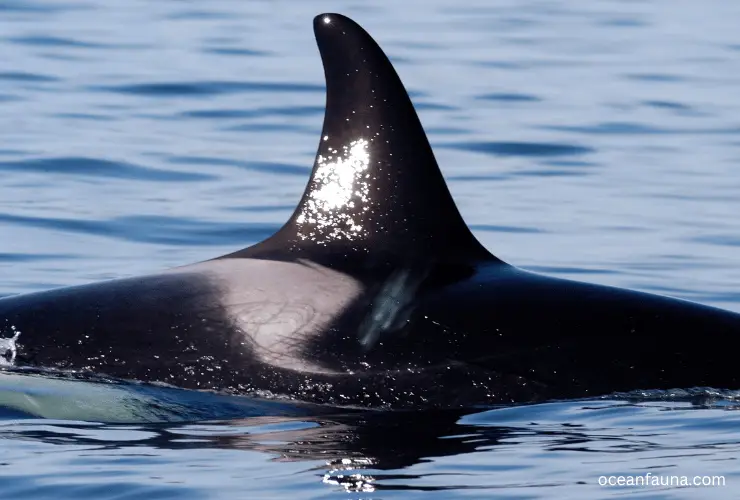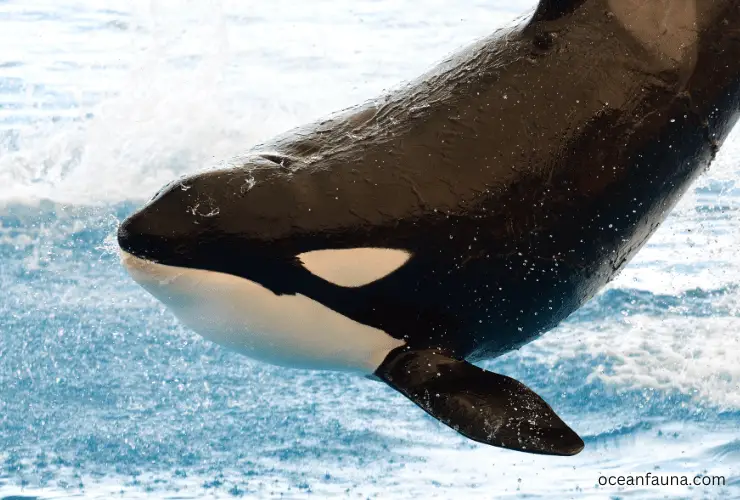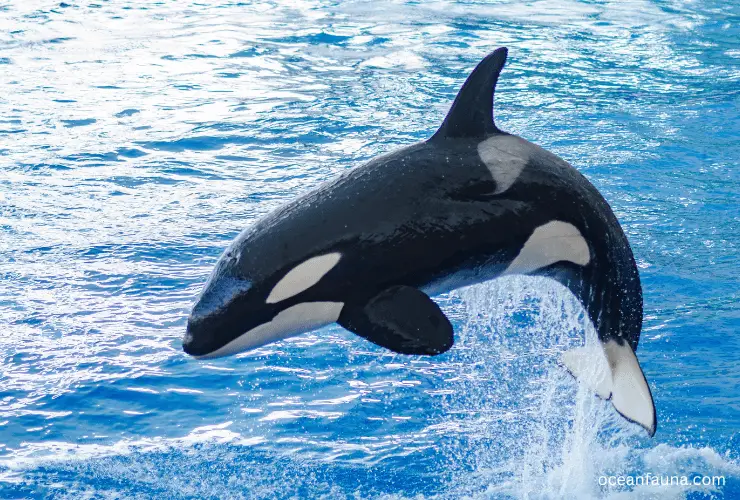Physical and emotional issues with environmental influences can all cause an orca’s dorsal fin to bend. But the primary factor that should be considered is their habitat – particularly when it comes to captive versus wild orcas.
In general, these fins will usually appear folded, bent, or collapsed in captivity rather than in the ocean or SeaWorld settings. In this article, I will discuss more detail about this fact.
Anatomy: Orca’s Dorsal Fin
The dorsal fin of a killer whale or orca is a prominent physical feature that can grow up to six feet tall. It is located on their back, specifically in the area of their spine. The dorsal fin is made of fibrous tissue, and it is supported by a series of connective tissue called ray bones.

Male orcas typically have larger dorsal fins than females and are usually more pointed. Females’ dorsal fins are smaller and more curved. Dorsal fins have a significant role in the orca’s life, such as serving as a rudder for steering and balancing while swimming.
It also plays a crucial role in thermoregulation, and orcas often use their dorsal fins for communication and social interactions as they make various gestures, such as waving and slapping.
The structure of dorsal fins of different marine mammal species often varies. For instance, the dorsal fins of orcas do not fold over, as seen in many shark species. The variations in dorsal fins can aid in the identification of individual whales.
In most orcas, the dorsal fins are unusually shaped due to injuries or deformities. Some captive orcas in marine parks have collapsed dorsal fins that are believed to be a result of injury, stress, and abnormal living conditions. Read on to know why orca fins curl or bend.
Is It Normal for Orca Fins To Bend?
It is not normal for orca fins to bend. In fact, a straight dorsal fin is a vital characteristic of a healthy orca in the wild. Bent fins are typically a sign of physical and emotional stress, which is often related to captivity.
In the wild, orcas swim long distances and have a wide range of social interactions, which keeps them mentally and physically stimulated. In captivity, however, they are confined to small tanks and have little social interaction, which can lead to boredom, depression, and physical harm.
Some captive orcas may even resort to repetitive and damaging behaviors, like banging their heads against the walls or chewing on concrete, which can further damage their fins.
Nevertheless, a bent dorsal fin is often considered a sign of distress in captive orcas and is a common concern for animal welfare advocates.
Do All Orcas Have Bent Dorsal Fins?
No, not all orcas have bent dorsal fins. This physical characteristic is most common in orcas that have been held in captivity.
In the wild, the dorsal fins of orcas are usually upright and straight, indicating good health and well-being. However, in captivity, the space available for orcas to swim is limited, which can result in their dorsal fins curving over time.

The reasons for this curvature are still being researched. It may be due to a combination of factors, including the orca’s confinement, their diet, and their lack of exercise.
However, not all captive orcas have bent dorsal fins, and some wild orcas may also have naturally bent dorsal fins.
Why Do Orca Fins Bend in Captivity?
One of the most tragic consequences of orca captivity is the phenomenon of bent fins. This is when the dorsal fin of an orca appears to droop significantly to one side or even curve into a semi-circle.
Bent fins are common in captive orcas but are virtually unheard of in their wild counterparts. There are several theories as to why this happens, and we will explore each in detail below.
Limited Space and Movement Restrictions
Orca whales in the wild swim up to 100 miles a day, whereas captive orca is confined to small tanks, which are less than 1% of the size of their natural habitat.
Limited space causes physical and emotional damage, leading to lethargy and depression. Thus, captive orca tends to spend most of their time at the surface where they’re visible, resulting in gravitational pressure on the dorsal fin. Over time, this results in a curved fin.
Temperature and Chemical Composition of Water
The temperature and chemical composition of the water in the tanks can also cause Orca fins to bend. Warmer temperatures disrupt collagen’s structure and rigidity, which can cause the collagen in the dorsal fin to break down.
The chemicals in the water, such as high levels of chlorine or copper, can also irritate the skin and damage the fin.
Gravity
Wild orcas have the buoyancy of the ocean to support their weight. However, the bottom of the pool supports the animal’s weight in captivity. This could lead to a “floppy” dorsal fin, especially as the orca grows in size.
Stress
Stress is a significant factor contributing to bent dorsal fins. Orca whales live in pods in the wild, where social connection and communication are crucial.
On the other hand, captive environments result in social isolation and prevent the formation of an essential network of relationships. The stress of captivity leads to the release of hormones such as cortisol, which weakens the collagen, leading to a floppy dorsal fin.
Genetics
Some studies suggest that genetics might contribute to bent dorsal fins. Captive breeding programs result in inbreeding, which can lead to weakened or deformed dorsal fins. Proper studies need to be conducted to verify these claims.
Why Do Orca Fins Bend in The Wild?

It’s rare to observe collapsed dorsal fins on orcas in the wild, yet it is quite common for those held captive. Yet even in the wild, bent or collapsed dorsal fins can be noticed, particularly among young and elderly whales. Let us take an insightful look into why this might happen.
Injury
One of the main causes of dorsal fin collapse is physical injury. Killer whales are social and highly active animals that rely on their fins for balance and maneuverability. They can sustain injuries from fights with other orcas, collisions with boats, or entanglement in fishing gear.
A damaged fin can cause the supporting connective tissues to weaken or shrink, leading to partial or complete collapse over time.
Old Age
As orcas age, their dorsal fins naturally become less stiff and more prone to bending, much like an elderly person’s posture changes over time.
Older killer whales may also experience muscle loss around the fin and reduced elasticity in the skin, which can contribute to a collapsed appearance.
Emaciation
When an orca is malnourished or underfed, its body may begin to consume its fat stores for energy, which can lead to muscle wasting, including in the dorsal fin. In extreme cases, the fin can become noticeably bent or floppy due to significant loss of body mass.
Exposure to Oil Spills
Oil spills can have a devastating impact on ocean life, including killer whales. When exposed to crude oil, the toxic compounds can damage their skin and tissues, leading to inflammation, blistering, and chemical burns that can weaken or deform the dorsal fin.
Oil can also disrupt the orca’s metabolism, causing it to dehydrate and lose body mass, further exacerbating the bent fin appearance.
Dehydration and Poor Health
Dehydration and overall poor health can be another cause of dorsal fin collapse in wild orcas. Inadequate hydration can lead to muscle weakness and fatigue, impacting the dorsal fin’s structure and strength.
Additionally, orcas that are suffering from chronic health conditions, such as infections or parasites, may experience reduced mobility and muscle atrophy that can affect the fin.
How Long Do Killer Whales Live with Fully Collapsed Dorsal Fins?
Research has shown that killer whales with fully collapsed dorsal fins have a slightly shorter life expectancy compared to their counterparts with upright fins. While the average lifespan of a wild killer whale ranges between 30-50 years regarding gender, those with floppy fins typically live only up to 20-40 years.
However, the duration of time a killer whale can live with a fully collapsed dorsal fin can vary based on the reason for the droop.
In the case of Yucalta, a killer whale who has survived with a fully flopped fin for eight years, it is speculated that the cause of the dorsal fin’s state is an injury rather than a result of major stress or illness. In general, fully collapsed dorsal fins can also occur due to factors such as lack of exercise, weight gain, or even genetic predisposition.
Can An Orca Fin Straighten?
Unfortunately, it cannot be straightened once an orca fin becomes bent or collapsed. This is because the fin is made up of a complex system of connective tissues that provide it with the necessary support and rigidity to maintain its shape. Once these structures are damaged, they cannot be repaired or regrown, resulting in a permanently bent fin.

This issue is particularly common among male orcas, as their fins can grow up to 30 feet tall and weigh as much as 16,000 pounds, making them more susceptible to collapsing or bending. The other causes of this phenomenon are discussed above.
Conclusion
Hopefully, now you have a compact knowledge of killer whales’ or orcas’ fins and why they bend or collapse.
Remember, orcas are more prone to dorsal fin collapse in captivity due to stress and lack of exercise. In the wild, the causes may vary from old age, poor health, exposure to oil spills, or emaciation.
Therefore, we must continue to invest in conservation efforts and advocate for better living conditions for our beloved killer whales.


1 thought on “Why Do Orca Fins Bend? [In Wild & Captivity]”